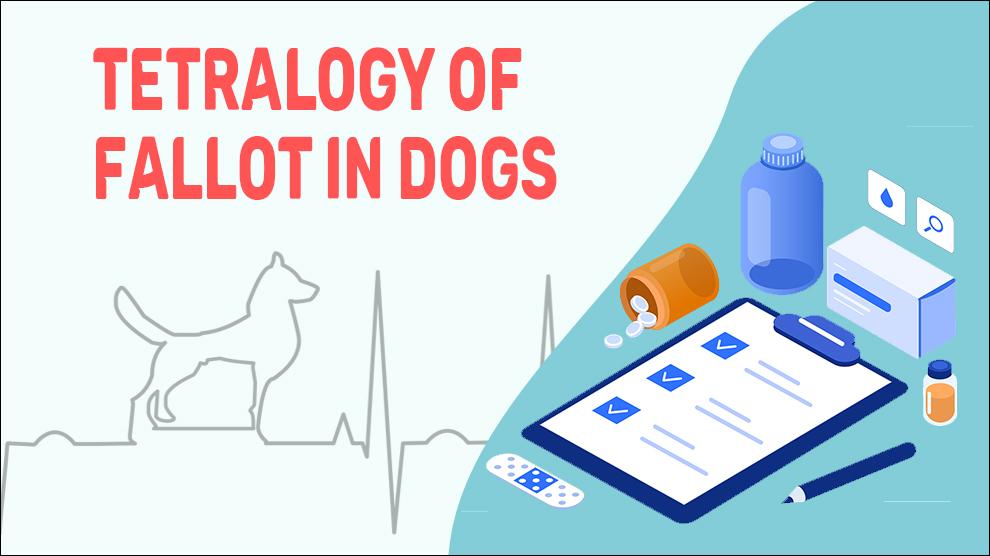What Is Tetralogy Of Fallot In Dogs?
Tetralogy of Fallot (TF) is a rare but complex conotruncal defect and most prevalent cyanotic heart disease that affects approximately 1 in 5000 dogs. The multifaceted condition involves 3 anatomical defects and 1 secondary change in the heart. The components are ventricular septal defect (VSD), dextroaorta - dextroposition of the aorta with septal override, Pulmonic stenosis (PS), and Right ventricular hypertrophy.
- Pulmonic stenosis (PS): This is caused by congenital narrowing of the pulmonic outflow tract; supravalvular tissues, or subpulmonic region or it is due to a poorly formed pulmonic valve (valvular stenosis). This leads to a narrowing of the area causing restriction of flow from the right ventricle into the pulmonary artery- the artery that enters the lungs. PS is the third most commonly reported congenital cardiac defect.
- Ventricular septal defect (VSD): The formation of the septum is incomplete and an opening or hole (defect) in the wall (septum) remains between the 2 ventricles. Interventricular septum defect allows the deoxygenated blood (after the oxygen has depleted) that travels from the right atrium to the right ventricle may be shunted directly to the left ventricle. This is due to rather high pressure of the right ventricular outflow tract than resistance through the left ventricular outflow tract. Deoxygenated blood completely evades the lungs and consequently does not become oxygenated.
- Overriding aorta (“dextroaorta”): In a normal heart, the aorta is located above the left side of the heart; an overriding aorta is placed above a ventricular septal defect. The normal aorta connects to the left ventricle and systemic arteries receive oxygenated blood. However, an overriding aorta is also partly attached to the right ventricle and the aorta will be directly supplied with some deoxygenated blood from the right ventricle, somewhat evading the lungs. An overriding aorta in combination with VSD makes right-to-left shunting even more possible.
- Right ventricular hypertrophy: Secondary to the pulmonic stenosis, RVH occurs and the right ventricle exerts increased force while trying to pump blood through the stenosis, the ventricle musculature experiences concentric hypertrophy.
Symptoms Of Tetralogy Of Fallot In Dogs
- Abdominal distension
- Arrhythmia
- Dyspnea (shortness of breath) / shallow or Labored breathing
- Collapse or fainting
- Ascites (fluid build-up in the abdominal cavity)
- Cyanosis - Low oxygen saturation causing blue or purple coloration of the skin and mucous membranes
- Seizures
- Exercise intolerance
- Lack of appetite
Treatment Options For Tetralogy Of Fallot In Dogs
Phlebotomy: This is also called a blood draw or venipuncture. This treatment may be performed so as to reinstate the balance of hematocrit (PCV- packed cell volume) to normal levels. The removed blood will be substituted with IV fluid at a ratio of 1:2 times the quantity of blood drawn.
Corrective Surgery: Surgical techniques such as the surgical connection between the left subclavian artery to a pulmonary artery (anastomosis) and cardiopulmonary bypass have been attempted a few times with varying success.
Hydroxyurea: (Hydroxycarbamide) is a myelosuppressive agent This treatment is an alternative to phlebotomy in order to restore hematocrit to ideal levels and it produces reversible bone marrow suppression.
Beta-blockers: Propranolol, Atenolol
Home Remedies For Tetralogy Of Fallot In Dogs
Herbs: Ginger, Hawthorn, Dandelion, Parsley, Cayenne
Relaxing Herbs: Valerian, Chamomile, and California poppy
Dietary Supplements: Vitamins A, B6, C, and E Carnitine-rich foods, L-Taurine, Coenzyme Q10, Magnesium, and Selenium
How To Prevent Tetralogy Of Fallot In Dogs?
There are no dependable methods to prevent Tetralogy of Fallot in dogs, particularly since it is hereditary. It is better to weed out the affected dogs when breeders think about breeding or check the roots before you get a dog from a susceptible lineage.
Affected Dog Breeds Of Tetralogy Of Fallot
Basset Hound, Beagle, Boxer, Cocker Spaniel, Chow Chow, Chihuahua, English Bulldog, German Shepherd, Keeshond, Miniature Schnauzer, Terrier Dog Breeds, Samoyed
Causes And Prognosis For Tetralogy Of Fallot In Dogs
1. Causes:
Congenital
2. Mortality:
The severity of the obstruction usually determines the consequences of Tetralogy of Fallot. Pressure overload of the right ventricle is the cause of major clinical manifestations. Almost 80% of dogs with TF develop clinical signs within the first year of life. In severe instances, TF can cause sudden death.
3. Diagnosis:
- A complete blood count (CBC), chemistry profile
- Urinalysis
- Electrocardiogram
- Cardiac ultrasound
- Echocardiography
4. Prognosis:
The prognosis for recovery from TF surgery is guarded, with most of the dog's illness being managed by medications and behavioral therapy.
Severe TF-affected dogs will also have other concurrent defects of the heart that affects the outcome of treatment. Dogs that are severely affected will start to manifest symptoms within the first year of life.
When To See A Vet For Tetralogy Of Fallot In Dogs?
Time to visit the vet clinic for an examination, if you notice any of the following:
- Arrhythmia
- Dyspnea (shortness of breath) / shallow or Labored breathing
- Collapse or fainting
- Ascites (fluid build-up in the abdominal cavity)
Food Suggestions For Tetralogy Of Fallot In Dogs
Foods to avoid
- Salty Foods should be discontinued
- Avoid all canned, frozen, and prepared pet foods
- Cured meats, fish fillets, and corned beef
- Snack foods (chips, pretzels, crackers, etc)
ACCEPTABLE FOODS
- Lean, home-cooked meats (chicken, beef, fish, turkey)
- Rice (plain white or brown rice, not flavored)
- Low-sodium cheese (check out the Heart Healthy labeling)
- Homemade soup, bone broth, organ meats, eggs
- Whole Grains - oats, barley, Brown rice, and buckwheat
- Grain-free dog foods (containing legumes, lentils, and potatoes)
- Fresh vegetables/fruit (carrots, banana, green beans, apple, orange)
Conclusion
Tetralogy of Fallot in dogs is a non-inflammatory, progressive disease that affects the dog’s heart and can cause problems in its daily life. The prognosis for TF in dogs depends on its severity and the promptness of treatment. In general, surgical repair is not a viable option and the dogs must be managed through medication and behavioral treatment.

















